Microstructural Organization and Mechanical Properties of 5356 Aluminum Alloy Wire Arc Additive Manufacturing Under Low Heat Input Conditions
Abstract
:1. Introduction
2. Test Materials and Methods
3. Results and Discussion
3.1. WAAM Sample Forming Analysis
3.2. XRD Analysis
3.3. Microstructure Analysis
3.4. EDS Analysis
3.5. Microhardness Analysis
3.6. Tensile Properties and Fracture Morphology
4. Conclusions
- (1)
- As the heat input increases from 87.5 J/mm to 190.0 J/mm, both the width and single-layer height of the vertical wall specimen exhibit an increasing trend. The specimen width increases from 5.22 mm at 87.5 J/mm to 8.87 mm at 190.0 J/mm, a change of 3.65 mm, indicating a noticeable increase. The single-layer height increases from 1.38 mm to 1.56 mm, a change of 0.16 mm, which is relatively small. Overall, the effect of the heat input on the specimen width is greater than on the single-layer height. Furthermore, when the heat input is 120 J/mm, the specimen formation is optimal.
- (2)
- The microstructure of the vertical wall specimen mainly consists of an α(Al) matrix and a skeletal β(Al3Mg2) phase. As the heat input increases, part of the β(Al3Mg2) phase gradually dissolves into the α(Al) matrix, resulting in the decreased distribution density, reduced quantity, and increased size of the β(Al3Mg2) phase.
- (3)
- [Q13] During the increase in heat input from 87.5 J/mm to 154.2 J/mm, the average hardness gradually increases from 69.40 HV to 77.89 HV. However, when the heat input increases to 190.0 J/mm, the excessive heat input slows the cooling rate, resulting in grain growth and a decrease in microhardness to 73.56 HV. Additionally, the hardness increases gradually from the bottom to the top of the specimen.
- (4)
- As the heat input increases, the tensile strength and elongation of both horizontal and vertical samples first increase, then decrease. Horizontal samples show slightly higher tensile strength and elongation. Fracture surfaces in both transverse and longitudinal tests exhibit dense dimples, indicating ductile fracture.
- (5)
- [Q13] The microstructure and mechanical properties of the 5356 aluminum alloy WAAM sample exhibit regional differences. In the upper region, the β(Al3Mg2) phase is evenly distributed, with high density and small size, showing fine and uniform fracture dimples. The microhardness and mechanical properties are optimal, with a tensile strength of 245.88 MPa. In the middle region, the distribution density of the β phase significantly decreases, with reduced quantity and increased size. The fracture dimples are relatively uniform but slightly coarser, resulting in a decrease in microhardness and mechanical properties. In the lower region, due to a higher undercooling degree, no significant dissolution of the β phase occurs. The phase density in the α matrix is relatively high, and the fracture dimples are large and unevenly distributed, leading to the lowest microhardness and mechanical properties, with a tensile strength of 236.00 MPa.
Author Contributions
Funding
Data Availability Statement
Acknowledgments
Conflicts of Interest
References
- Pan, J.; Yuan, B.; Ge, J.; Ren, Y.; Chen, H.; Zhang, L.; Lu, H. Influence of arc mode on the microstructure and mechanical properties of 5356 aluminum alloy fabricated by wire arc additive manufacturing. J. Mater. Res. Technol. 2022, 20, 1893–1907. [Google Scholar] [CrossRef]
- Gungor, B.; Kaluc, E.; Taban, E.; Aydin, S.I.K. Mechanical and microstructural properties of robotic Cold Metal Transfer (CMT) welded 5083-H111 and 6082-T651 aluminum alloys. Mater. Design 2014, 54, 207–211. [Google Scholar] [CrossRef]
- Tao, Y.; Ren, X.; Chen, S.; Jiang, X. Grain refinement and property improvements of Al–Zn–Mg–Cu alloy by heterogeneous particle addition during wire and arc additive manufacturing. J. Mater. Res. Technol. 2022, 16, 824–839. [Google Scholar] [CrossRef]
- Karayel, E.; Bozkurt, Y. Additive manufacturing method and different welding applications. J. Mater. Res. Technol. 2020, 9, 11424–11438. [Google Scholar] [CrossRef]
- Chen, S.; Xu, M.; Yuan, T.; Jiang, X.; Zhang, H.; Zheng, X. Thermal–microstructural analysis of the mechanism of liquation cracks in wire-arc additive manufacturing of Al–Zn–Mg–Cu alloy. J. Mater. Res. Technol. 2022, 16, 1260–1271. [Google Scholar] [CrossRef]
- Wu, B.; Pan, Z.; Ding, D.; Cuiuri, D.; Li, H. Effects of heat accumulation on microstructure and mechanical properties of Ti6Al4V alloy deposited by wire arc additive manufacturing. Addit. Manuf. 2018, 23, 151–160. [Google Scholar] [CrossRef]
- Ding, D.; Pan, Z.; Van Duin, S.; Li, H.; Shen, C. Fabricating superior NiAl bronze components through wire arc additive manufacturing. Materials 2016, 9, 652. [Google Scholar] [CrossRef]
- Shen, C.; Pan, Z.; Cuiuri, D.; Dong, B.; Li, H. In-depth study of the mechanical properties for Fe3Al based iron aluminide fabricated using the wire-arc additive manufacturing process. Mater. Sci. Eng. A 2016, 669, 118–126. [Google Scholar] [CrossRef]
- Xu, X.; Ding, J.; Ganguly, S.; Diao, C.; Williams, S. Oxide accumulation effects on wire+ arc layer-by-layer additive manufacture process. J. Mater. Process. Technol. 2018, 252, 739–750. [Google Scholar] [CrossRef]
- Gu, J.; Bai, J.; Ding, J.; Williams, S.; Wang, L.; Liu, K. Design and cracking susceptibility of additively manufactured Al-Cu-Mg alloys with tandem wires and pulsed arc. J. Mater. Process. Technol. 2018, 262, 210–220. [Google Scholar] [CrossRef]
- Aldalur, E.; Suárez, A.; Veiga, F. Metal transfer modes for Wire Arc Additive Manufacturing Al-Mg alloys: Influence of heat input in microstructure and porosity. J. Mater. Process. Technol. 2021, 297, 117271. [Google Scholar] [CrossRef]
- Sahul, M.; Pavlík, M.; Sahul, M.; Kovačócy, P.; Martinkovič, M. Effect of travel speed on the properties of 5087 aluminum alloy walls produced by wire and arc additive manufacturing. J. Mater. Eng. Perform. 2024, 33, 8582–8600. [Google Scholar] [CrossRef]
- Wang, B.; Li, R.; Zhou, X.; Liu, F.; Wei, L.; Tian, L.; Song, X.; Tan, C. Insight into role of arc torch angle on wire arc additive manufacturing characteristics of ZL205A aluminum alloy. Materials 2024, 17, 3771. [Google Scholar] [CrossRef] [PubMed]
- Zhang, C.; Gao, M.; Zeng, X. Workpiece vibration augmented wire arc additive manufacturing of high strength aluminum alloy. J. Mater. Process. Technol. 2019, 271, 85–92. [Google Scholar] [CrossRef]
- Zhou, Y.; Lin, X.; Kang, N.; Huang, W.; Wang, Z. Mechanical properties and precipitation behavior of the heat-treated wire+ arc additively manufactured 2219 aluminum alloy. Mater. Charact. 2021, 171, 110735. [Google Scholar] [CrossRef]
- Derekar, K.; Lawrence, J.; Melton, G.B.; Addison, A.; Zhang, X.; Xu, L. Influence of interpass temperature on wire arc additive manufacturing (WAAM) of aluminium alloy components. In Proceedings of the MATEC Web of Conferences, Sibiu, Romania, 7–9 June 2017; p. 5001. [Google Scholar] [CrossRef]
- Ahsan, M.R.; Seo, G.J.; Fan, X.S.; Liaw, P.K.; Motaman, S.; Haase, C.; Kim, D.B. Effects of process parameters on bead shape microstructure and mechanical properties in wire+ arc additive manufacturing of Al01CoCrFeNi high-entropy alloy. J. Manuf. Process. 2021, 68, 1314–1327. [Google Scholar] [CrossRef]
- Wang, S.; Gu, H.; Wang, W.; Li, C.; Ren, L.; Wang, Z.; Zhai, Y.; Ma, P. The influence of heat input on the microstructure and properties of wire-arc-additive-manufactured Al-Cu-Sn alloy deposits. Metals 2020, 10, 79. [Google Scholar] [CrossRef]
- Zhou, Y.; Lin, X.; Kang, N.; Huang, W.; Wang, J.; Wang, Z. Influence of travel speed on microstructure and mechanical properties of wire+ arc additively manufactured 2219 aluminum alloy. J. Mater. Sci. Technol. 2020, 37, 143–153. [Google Scholar] [CrossRef]
- Wang, D.; Lu, J.; Tang, S.; Yu, L.; Fan, H.; Ji, L.; Liu, C. Reducing porosity and refining grains for arc additive manufacturing aluminum alloy by adjusting arc pulse frequency and current. Materials 2018, 11, 1344. [Google Scholar] [CrossRef]
- Lupo, M.; Ajabshir, S.Z.; Sofia, D.; Barletta, D.; Poletto, M. Experimental metrics of the powder layer quality in the selective laser sintering process. Powder Technol. 2023, 419, 118346. [Google Scholar] [CrossRef]
- Prasad, R.; Yuvaraj, N.; Vipin; Gopal, A. Experimental investigation of process parameters of cold metal transfer welding-based wire arc additive manufacturing of aluminum 4047 alloy using response surface methodology. Weld. World 2024, 68, 2837–2852. [Google Scholar] [CrossRef]
- Chen, C.; Sun, G.; Du, W.; Liu, J.; Zhang, H. Effect of equivalent heat input on WAAM Al-Si alloy. Int. J. Mech. Sci. 2023, 238, 107831. [Google Scholar] [CrossRef]
- Zhao, Y.; Jia, Y.; Chen, S.; Shi, J.; Li, F. Process planning strategy for wire-arc additive manufacturing: Thermal behavior considerations. Addit. Manuf. 2020, 32, 100935. [Google Scholar] [CrossRef]
- Guo, Y.; Han, Q.; Hu, J.; Yang, X.; Mao, P.; Wang, J.; Sun, S.; He, Z.; Lu, J.; Liu, C. Comparative study on wire-arc additive manufacturing and conventional casting of Al–Si alloys: Porosity, microstructure and mechanical property. Acta Metall. Sin. Engl. Lett. 2022, 35, 475–485. [Google Scholar] [CrossRef]
- Ma, Y.; Yang, Y.; Jia, X.; Zhao, H.; Qu, Z.; Wang, D.; Wang, B. Effect of welding heat input on microstructure and properties of coarse-grained HAZ of 500 MPa high-strength low-alloy steel. Trans. Indian Inst. Met. 2022, 75, 1877–1884. [Google Scholar] [CrossRef]
- Yu, C.; Zhang, D.; Liu, Z.; Wu, D.; Zhong, Y.; Wu, J. Study on nitrogen pores, microstructure, and mechanical properties of nickel-free high-nitrogen stainless steel fabricated via LDED regulated by heat input. Virtual Phys. Prototyp. 2025, 20, 2445711. [Google Scholar] [CrossRef]
- Nagasai, B.P.; Malarvizhi, S.; Balasubramanian, V. Effect of interlayer delay on microstructure and bead geometry of wire arc additive manufactured low carbon steel components. Int. J. Interact. Des. Manuf. 2023, 17, 939–946. [Google Scholar] [CrossRef]
- Protsenko, N.A. Status of normative base, certification and attestation of welding consumables in ukraine. Paton Weld. J. 2014, 6–7, 159–162. [Google Scholar] [CrossRef]
- Li, Y. The Situation of New National Standard Designations in GB/T3190-2008 “Chemical Composition of Deformed Aluminum and Aluminum Alloys”. Nonferrous Met. Process. 2009, 38, 20–21. [Google Scholar]
- Kutelu, B.J.; Ogundeji, F.O.; Aluko, A.O. Microstructure and Mechanical Properties of Electric arc welded Low-alloy Steel at Varied Welding Heat Input. Int. J. Adv. Multidiscip. Res. Stud. 2024, 4, 717–723. Available online: https://www.multiresearchjournal.com/arclist/list-2024.4.2/id-2565 (accessed on 18 January 2025).
- Liang, Y.; Shen, J.; Hu, S.; Wang, H.; Pang, J. Effect of TIG current on microstructural and mechanical properties of 6061-T6 aluminium alloy joints by TIG–CMT hybrid welding. J. Mater. Process. Technol. 2018, 255, 161–174. [Google Scholar] [CrossRef]
- Bai, J.; Yang, C.; Lin, S.; Dong, B.; Fan, C. Mechanical properties of 2219-Al components produced by additive manufacturing with TIG. Int. J. Adv. Manuf. Technol. 2016, 86, 479–485. [Google Scholar] [CrossRef]
- Liu, P.; Wang, Z.; Xiao, Y.; Horstemeyer, M.F.; Cui, X.; Chen, L. Insight into the mechanisms of columnar to equiaxed grain transition during metallic additive manufacturing. Addit. Manuf. 2019, 26, 22–29. [Google Scholar] [CrossRef]
- Bermingham, M.J.; StJohn, D.H.; Krynen, J.; Tedman-Jones, S.; Dargusch, M.S. Promoting the columnar to equiaxed transition and grain refinement of titanium alloys during additive manufacturing. Acta Mater. 2019, 168, 261–274. [Google Scholar] [CrossRef]
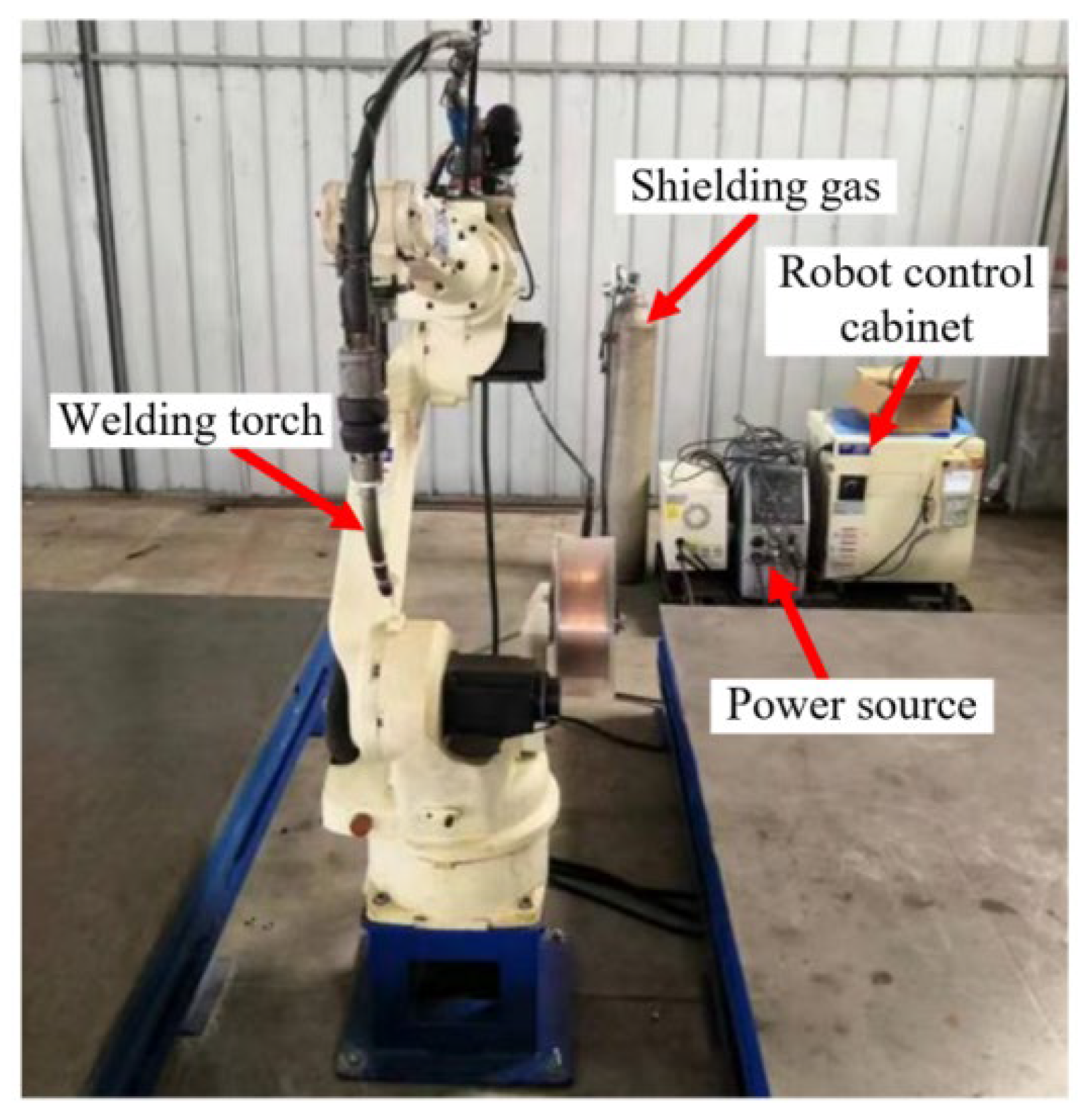


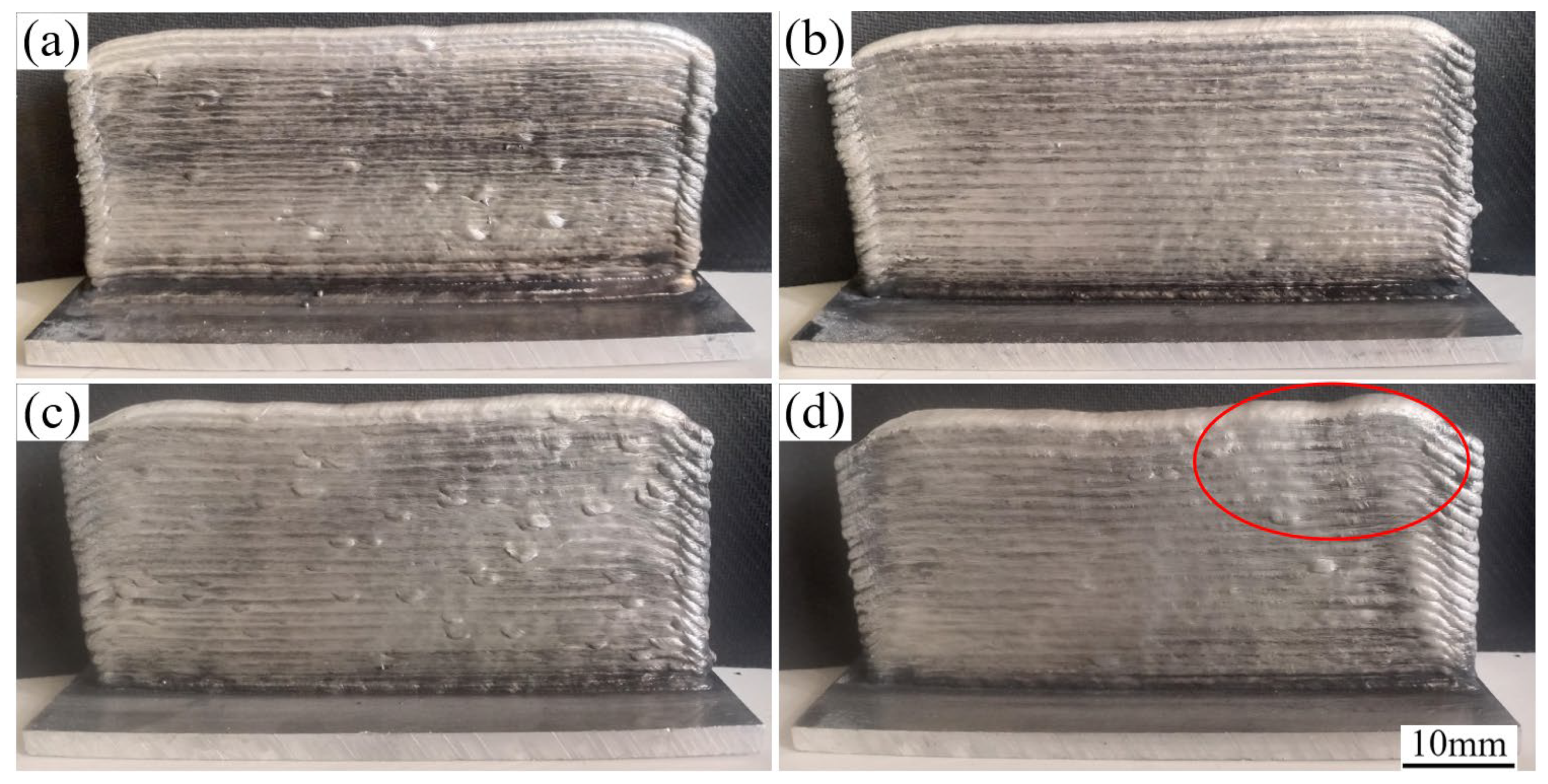

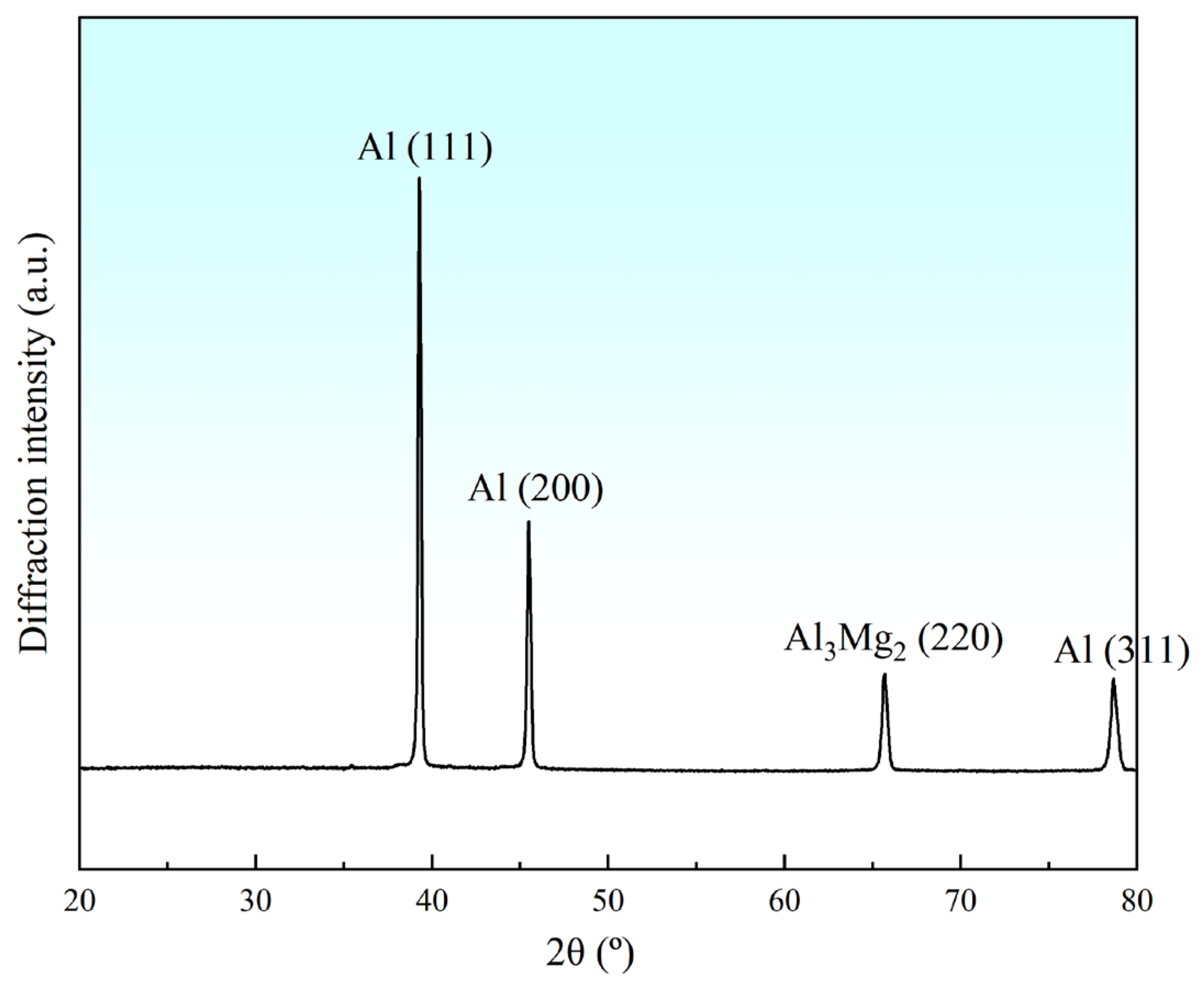

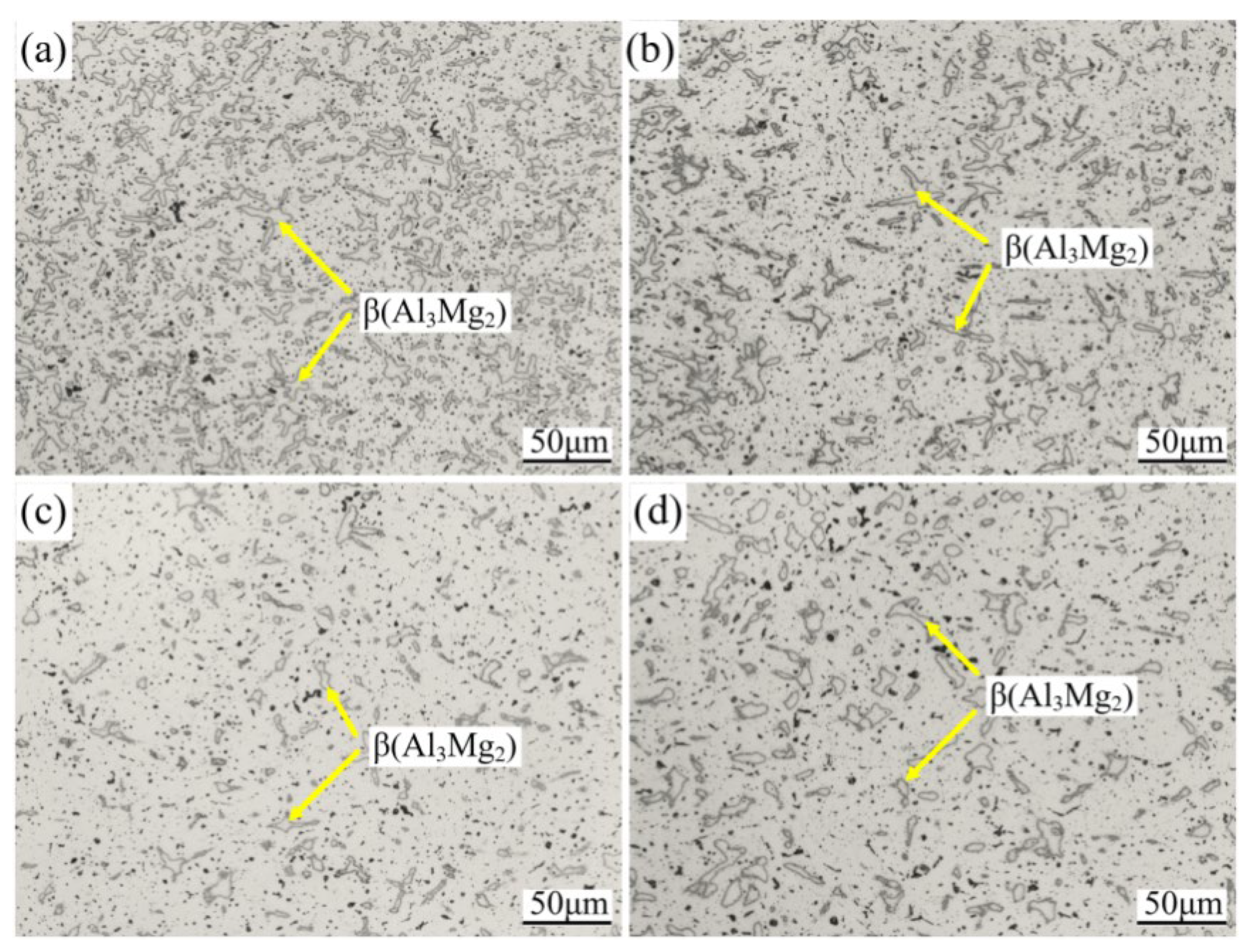
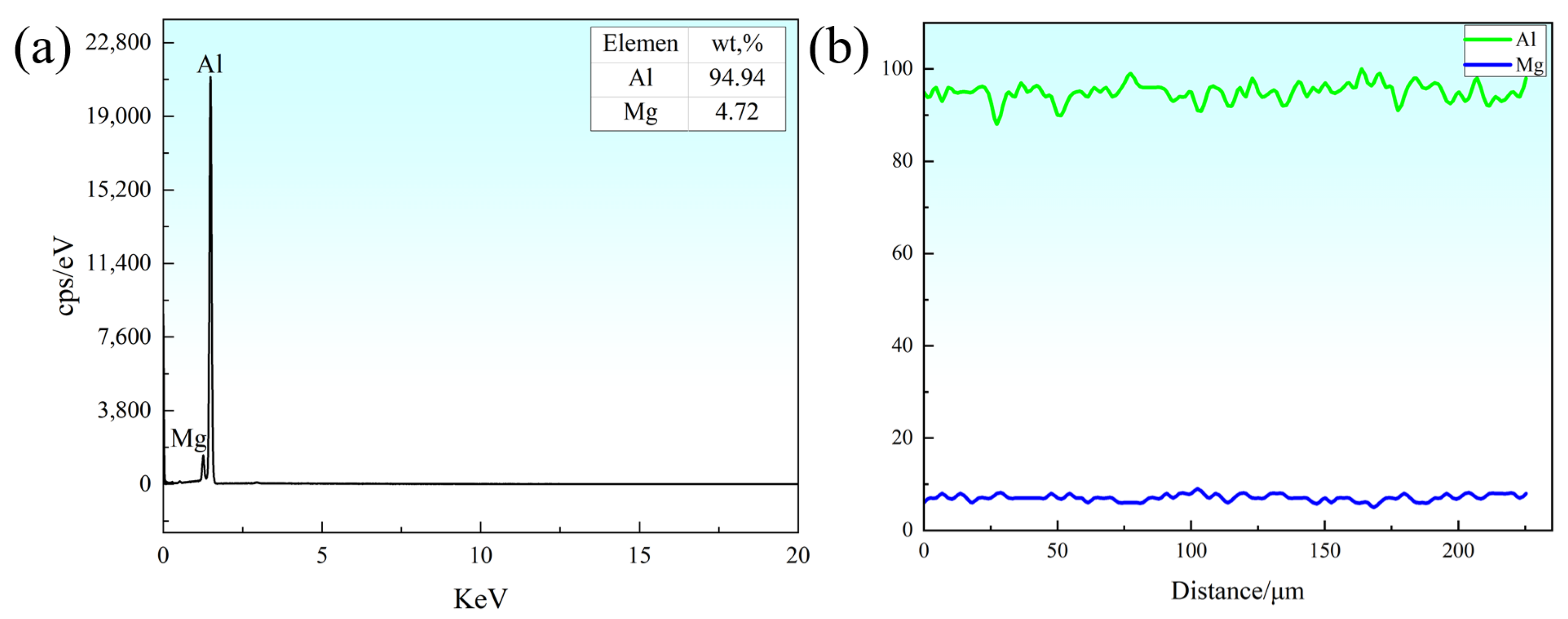
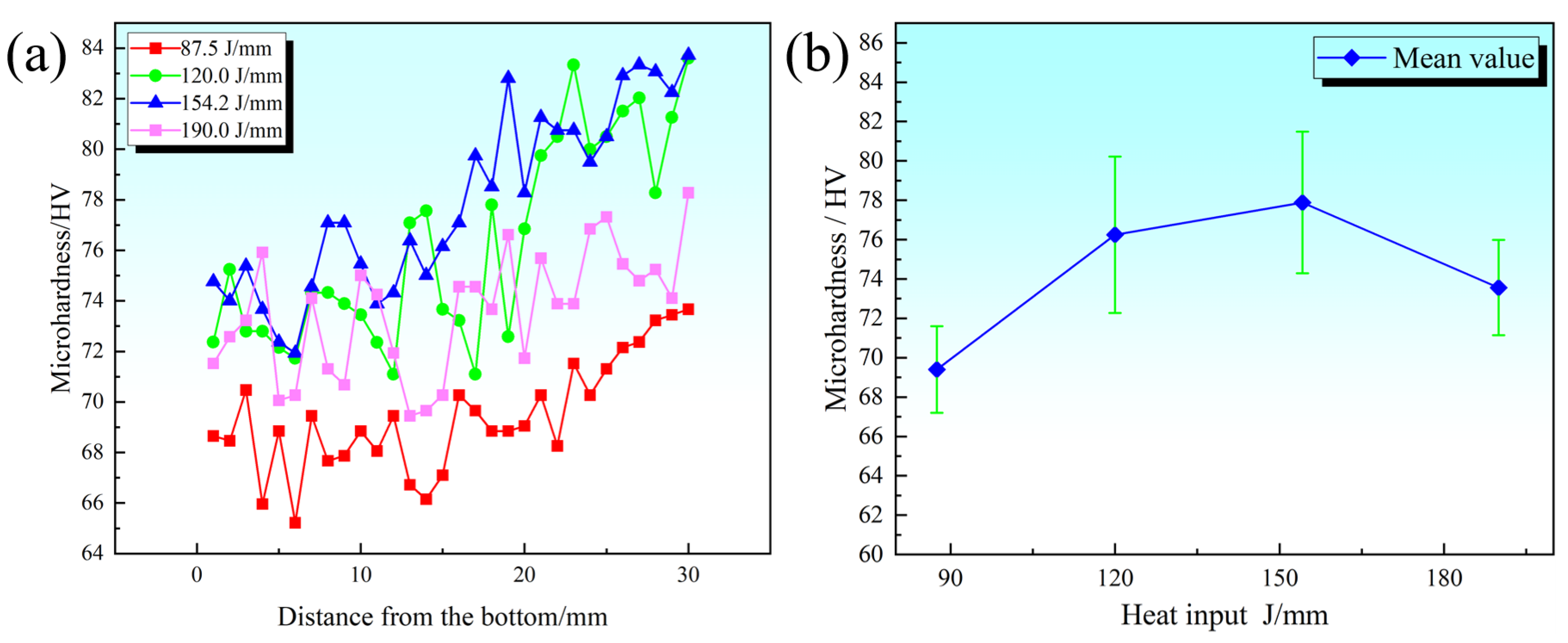


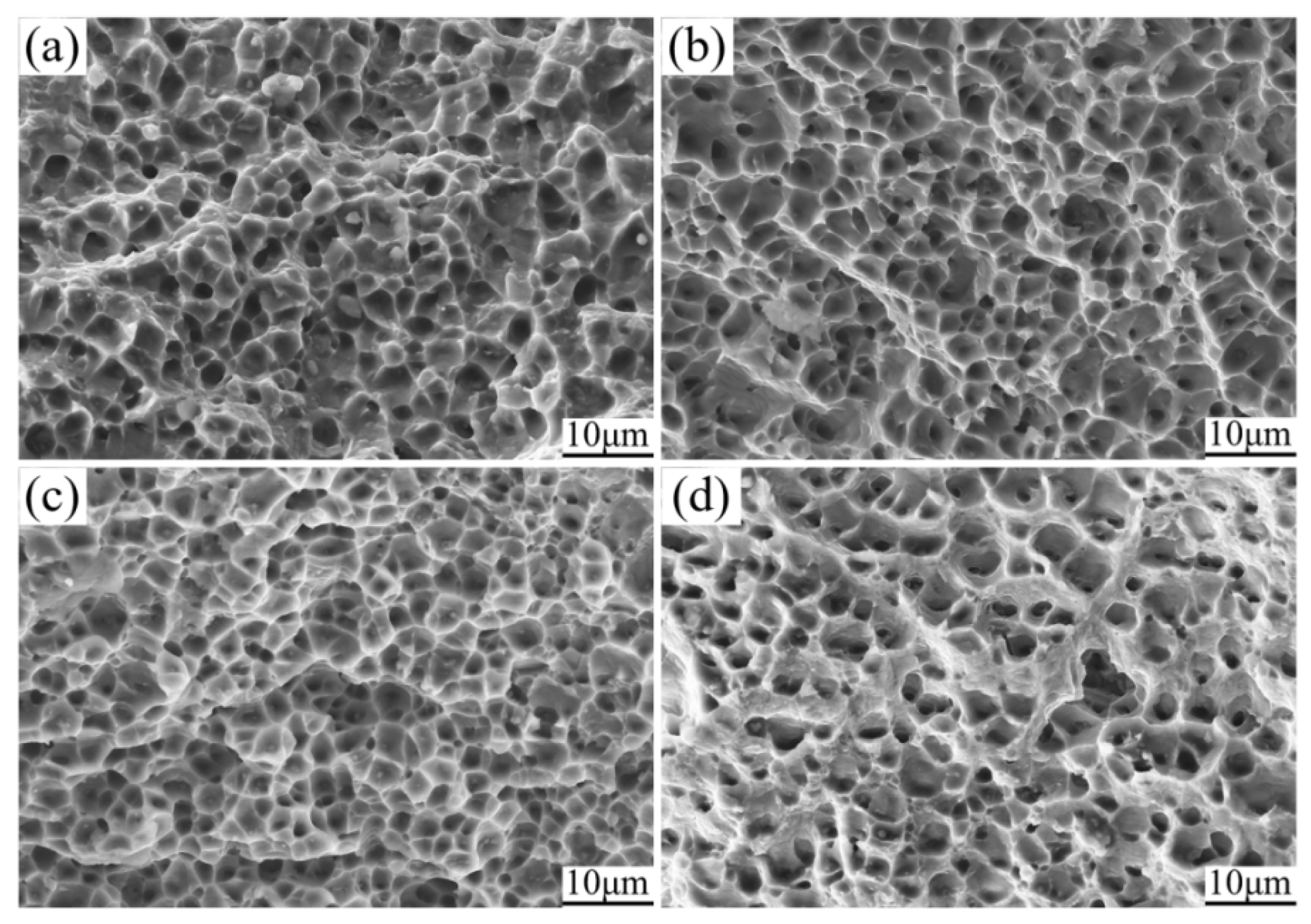
| Material | Al | Ti | Mg | Zn | Fe | Si | Mn | Cr | Cu | Zr |
|---|---|---|---|---|---|---|---|---|---|---|
| 5087 substrate | 92.15–93.55 | 0.15 | 4.5–5.2 | 0.25 | 0.40 | 0.25 | 0.7–1.1 | 0.05–0.25 | 0.05 | 0.1–0.2 |
| 5356 welding wire | 94.53 | 0.07 | 5 | 0.01 | 0.12 | 0.05 | 0.14 | 0.07 | 0.01 | – |
| Number | Welding Current/A | Welding Voltage/V | Welding Speed mm/s | Interlayer Waiting Time/s | Preheating Temperature/°C | Gas Flow L/min | Heat Input, J/mm |
|---|---|---|---|---|---|---|---|
| 1 | 30 | 17.5 | 6 | 30 | 90 | 15 | 87.5 |
| 2 | 40 | 18.0 | 6 | 30 | 90 | 15 | 120.0 |
| 3 | 50 | 18.5 | 6 | 30 | 90 | 15 | 154.2 |
| 4 | 60 | 19.0 | 6 | 30 | 90 | 15 | 190.0 |
Disclaimer/Publisher’s Note: The statements, opinions and data contained in all publications are solely those of the individual author(s) and contributor(s) and not of MDPI and/or the editor(s). MDPI and/or the editor(s) disclaim responsibility for any injury to people or property resulting from any ideas, methods, instructions or products referred to in the content. |
© 2025 by the authors. Licensee MDPI, Basel, Switzerland. This article is an open access article distributed under the terms and conditions of the Creative Commons Attribution (CC BY) license (https://creativecommons.org/licenses/by/4.0/).
Share and Cite
Zuo, X.; Lv, Z.; Wang, Y.; Chen, X.; Qi, W. Microstructural Organization and Mechanical Properties of 5356 Aluminum Alloy Wire Arc Additive Manufacturing Under Low Heat Input Conditions. Metals 2025, 15, 116. https://doi.org/10.3390/met15020116
Zuo X, Lv Z, Wang Y, Chen X, Qi W. Microstructural Organization and Mechanical Properties of 5356 Aluminum Alloy Wire Arc Additive Manufacturing Under Low Heat Input Conditions. Metals. 2025; 15(2):116. https://doi.org/10.3390/met15020116
Chicago/Turabian StyleZuo, Xiaogang, Zhimin Lv, Yuejie Wang, Xiaokang Chen, and Wenjun Qi. 2025. "Microstructural Organization and Mechanical Properties of 5356 Aluminum Alloy Wire Arc Additive Manufacturing Under Low Heat Input Conditions" Metals 15, no. 2: 116. https://doi.org/10.3390/met15020116
APA StyleZuo, X., Lv, Z., Wang, Y., Chen, X., & Qi, W. (2025). Microstructural Organization and Mechanical Properties of 5356 Aluminum Alloy Wire Arc Additive Manufacturing Under Low Heat Input Conditions. Metals, 15(2), 116. https://doi.org/10.3390/met15020116





